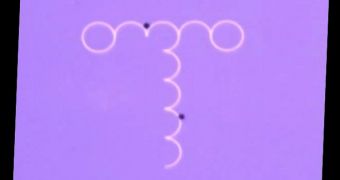By applying a principle used in studying the dynamics of liquids to the nanoscale, a group of researchers in the United States was recently able to set the basis for a new measuring technology that could be used to create the next generation of microfluidic (lab-on-a-chip) devices.
These instruments could allow doctors in underdeveloped countries and other poor areas to conduct low-cost biomedical investigations on their patients. The thing about these devices is that they carry out their analysis very fast and reliably, and that they can be adjusted to test for various chemicals.
The research group included graduate student Elizabeth Rapoport, assistant professor Geoffrey Beach, and former undergraduate student Daniel Montana, all from the Department of Materials Science and Engineering (DMSE) at the Massachusetts Institute of Technology (MIT).
Inspiration for the new approach was drawn from the behaviors of balls dropped in water. The smaller the diameter of the ball, the faster it plunges to the bottom of the container in which it was placed. The same principle will be used inside the new generation of microfluidic devices as well.
Details of the investigation are published in a recent issue of the scientific journal Lab on a Chip.
In the new devices, the balls are replaced by microscopic magnetic beads, which are coated in antibodies and other types of biomolecules. The presence of these compounds makes the beads able to stick to various other chemicals, some of which are expressed by pathogens and contaminants.
By subjecting the beads to the actions of a variable magnetic field, the MIT group was able to develop a way of trapping each individual structure. Studying how the beads move can provide data as to how large they are. If they are attached to dangerous, they will naturally be considerable heavier.
“We now have all the elements required to make a sensing device. The next step is to combine the pieces in an operational device and demonstrate its performance,” Beach explains. The team now plans to continue developing their new technology even further.
“It is very interesting how the researchers combine technologies that are well understood for applications in computing and data storage, and apply them to something completely different,” comments Ohio State University physics professor, R. Sooryakumar.
“These magnetic devices are potentially valuable tools that could go well beyond how one may normally expect them to be used. The ramifications, for example in food safety and health care, such as pathogen or cancer detection, are indeed exciting,” he concludes.

 14 DAY TRIAL //
14 DAY TRIAL //